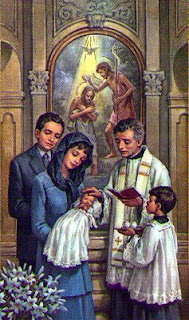A dear friend once related how in the 1930’s his Catholic mother had died in childbirth along with the infant. Because there was no priest present or available at the time of this sad event, the mother was later buried in a Catholic cemetery while the dead infant was buried outside the cemetery walls in the belief that the un-baptized were destined to spend an eternity in Limbo. This cruel treatment led me to research the question as to how the Church came to to such a sad decision and adopt the need for infant baptism.
The following explanation is primarily based on the writings of noted Catholic Church historian Thomas Bokenkotter :
Saint Augustine (354-420) worked out a theory to explain why the Church insisted on infant baptism. The sin of Adam, he argued, was transmitted to all his descendants through the act of procreation, and the stain of this sin could be removed only by baptism. And he did not shrink from drawing his logical conclusion: those who died without baptism would all be damned.
Infant baptism was by no means a universal practise. In fact, a variety of approaches can be found in the historical records of the third and fourth centuries: there were those, like the convert Emperor Constantine (d. 337), who delayed their baptism until the approach of death in the belief that it would wash them clean of all their sins and also enable them to escape the rigorous penances imposed by the sacrament of penance at the time. There were also those who delayed their children’s baptism until after their adolescent passions subsided, when they were believed less likely to succumb to temptation. On the other hand, with infant mortality rates extremely high, there were a growing number of parents who wanted their children baptized immediately after birth, let they die uncleansed. Within a hundred years after Augustine, infant baptism became the norm. The Council of Florence (1438-45) obliged parents to have the infant baptized shortly after birth.
The legitimacy of infant baptism was an issue first raised during the Reformation by the Anabaptist, who received the name (rebaptizers) from their practise of baptizing only adult believers. The movement first appeared in the Swiss provinces in 1525, but spread rapidly all over Europe. However, both the Roman Catholic and the Protestant authorities suppressed and persecuted Anabaptist, and thousands were killed or banished.[1]
Scriptural study no longer supports the necessity of infant baptism, while historical studies show that in the early Church, adult baptism was the norm and was performed with no sense of urgency. Often the catechumen had to wait years before being baptized. Moreover, the practise of making infant baptism the norm has helped to create the situation of a Church composed formally of a large, inert mass of nominal Christians who have little understanding of what it means to be a member of a Christian community. For them baptism has to do with getting into heaven. "Sorry, little innocent infant you cannot enter these gates - your not baptized" are not the words of a God who loves us unconditionally.
Thomas Bokenkotter, A Concise History of the Catholic Church, Rev. 1990
sic , Dynamic Catholicism - A Historical Catechism, 1992
sic , Dynamic Catholicism - A Historical Catechism, 1992
[1] John Bowden, editor, ‘Christianity – The Complete Guide’, Anabaptists p. 40

No comments:
Post a Comment